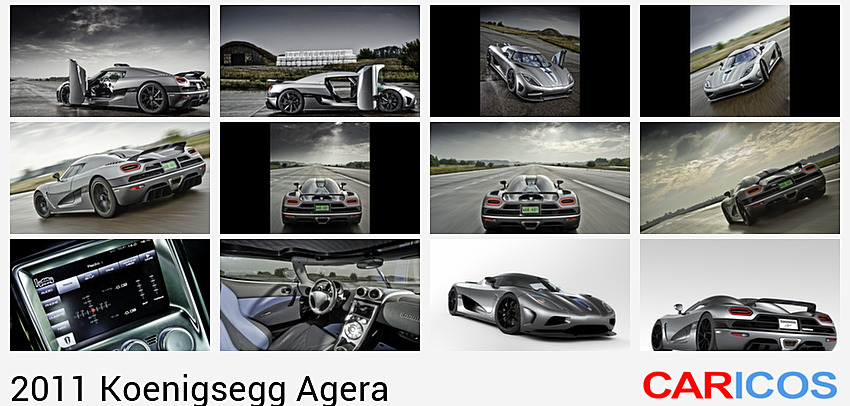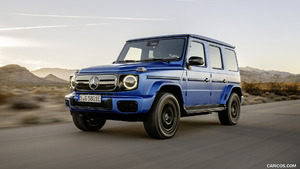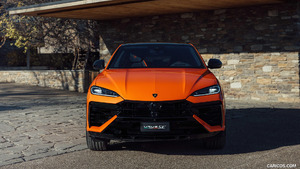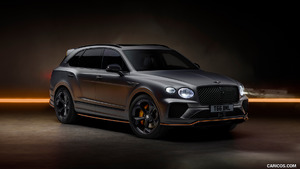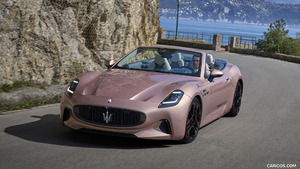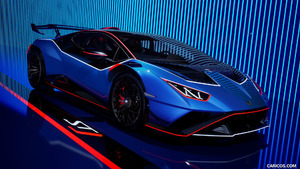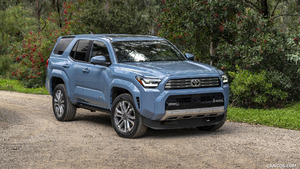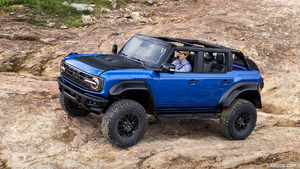Koenigsegg Agera
Although sharing the same values and philosophies as previous Koenigsegg models, the Agera takes the Koenigsegg experience to a completely new level.
Similar to all previous Koenigsegg hypercars, the new Agera is the brainchild of Christian von Koenigsegg. The Agera has come to life in order to set new benchmarks for hypercars when it comes to control, handling, speed, comfort, practicality and sheer driving enjoyment, while combining these features with clean, efficient and beautiful design.
The name Agera set the tone for the new project. Agera means “to take action” in Swedish. It is also short for the ancient Greek word Ageratos which means “ageless”. These two are very suitable meanings, for the car building the future of Koenigsegg.
The design
The Agera is designed with the minimalistic “less is more” philosophy in mind. This philosophy means that the shape of the car has to be purely functional with no added features except those purely needed to meet regulation, added safety, ergonomics, practicality and aerodynamics. We believe that if this philosophy is followed, the car will also be beautiful as it is purely purposeful. A good analogy is the evolution of a dolphin that has had to meet similar criteria in order to reach their present configuration through the evolution of nature.
The Agera is proportionate, compact and muscular. Its timeless, efficient and distinctive shape is truly a testament to time. The original shape and concept of the Koenigsegg CC, created 15 years ago, is still valid, fresh and highly competitive today. The Agera manage to stay true to the original philosophy, shape and size of the original CC. At the same time, it looks, feels and performs like something belonging to the future.
The engine
Koenigsegg differs from other low volume hypercar manufacturers by the fact that Koenigsegg develops and produces its own engine in-house. This is, by most observers and competitors, deemed as more or less impossible or way too expensive to even consider.
However, year after year Koenigsegg has proved them wrong. Not only are the engines developed in-house, they also have class leading characteristics in many important areas. To mention a few: Lightest and most compact hypercar engine in the world, weighing only 197 kg complete with flywheel, clutch, dry sump system, Inconel exhaust manifold with turbo. The low engine weight is quite astonishing, as the Agera engine also has class leading power and torque characteristics. To give an example, the Koenigsegg 5 litre V8 bi-turbo engine develops more 940 hp on 95 octane regular fuel. The Agera has over 1000 Nm of torque from 2500 rpm and 1100 nm from 3500 to 6000 rpm, showing great flexibility.
These are extraordinary numbers considering the size and reliability of the engine and they are obtained without forsaking drivability or flexibility. This is truly downsizing, without drawbacks. These characteristics make it one of the most flexible and easy to use hypercar engines in the world.
To give a hint of how different the Agera engine is compared to other production car engines, it is easy to look at the BMEP value (Brake Mean Effective Pressure) in the cylinders during maximum power output. The best production diesel and petrol engines from other leading manufacturers have a maximum BMEP of around 22 bar.
The Agera engine has a BMEP of 28 bar running on 95 octane fuel. This shows how extreme the Agera engine is, compared to any other production engine in the world. The reason why the Agera can obtain so high cylinder pressure, is due to some proprietary and critical factors, such as:
- A unique shape of the combustion chambers, improving the resistance against detonation. High cylinder head clamp load, enabled by a specially designed engine block. This has proven to give a zero failure rate to combustion overpressure, even considering the extreme cylinder pressures. A unique engine block design, where the cylinder sleeves are used to further stiffen the aluminium block. A connecting rod design reducing TDC dwell time and therefore enabling higher mean pressures without detonation. Exhaust manifold and intake plenum trumpets designed to ensure absence of RPM peak resonance and back pressure. An efficient ejector pump system reducing the crankcase pressure and aerodynamic losses.
The Koenigsegg engines also meet all the required emission standards in the world. This is nothing short of astounding, given their size and power output.
Furthermore no other production engine in the world, regardless of car type, has the same amount of power potential compared to its EU cycle average CO2 emission(310g of CO2) or cycle fuel consumption( 14,7 litre per 100 km / 16MPG). However, what makes Koenigsegg most proud is how drivable, smooth, responsive, torquey and reliable the Agera engine is – especially given its extreme performance.
The Agera engine complies with the most stringent environmental regulations in the world, EU5 and LEV2, and delivers a significant power increase compared to previous Koenigsegg engines.
Fuel consumption, and thus CO2 emissions, has been lowered. This is an astonishing feat for a 900+ hp hypercar. Turbo response is of vital importance when it comes to driving pleasure and the possibility to control massive amounts of power. Koenigsegg has coupled the latest generation turbo technology with patent pending and proprietary response/back pressure reduction system, invented by Christian von Koenigsegg to really give the Agera engine a competitive edge when combining maximum power while complying with the strictest emission regulations in the world.
Furthermore the large air to air intercooler on the left side of the engine exchanges enormous amounts of fresh air, eliminating the need for water in the intercooling system, thereby saving weight and avoiding heat soak issues, during extended performance driving.
Following the Koenigsegg tradition the engine has a dry sump lubrication in order to lower the engine as far as possible in the chassis and have full control of the crankcase oil even given the massive g-forces involved.
The large 80-litre fuel tank ensures long driving range, due to the relatively low average consumption. The Agera follows the previous generation Koenigsegg and has its fuel tank well protected, built-in centrally into the carbon fibre monocoque chassis. Since the fuel is centrally placed in the car, the weight distribution does not change regardless if the tank is full or empty. Thanks to the safe fuel tank position, the challenging US high-speed rear impact test, was passed at first trial.
The Agera has four intelligent return-less fuel pumps in order to deliver the correct amount of fuel at any given time. This reduces the energy needed to operate the fuel pumps and eliminates the waste of excessive fuel transport.
The Inconel/Titanium patent pending exhaust system is key in order for the Agera to achieve its remarkable emission and power levels. The exhaust system uses a completely new principle created by Christian von Koenigsegg. The new technology drastically reduces back pressure and gives earlier catalytic light off than any other turbo exhaust system. At the same time the acoustics of the exhaust has been examined carefully in order to maintain the typical Koenigsegg thunderous growl.
The transmission
The newly developed 7 speed gearbox for the Agera features a world’s first dual clutch system for a single input shaft gearbox.
In order to keep the gearbox light, compact strong and reliable, Koenigsegg together with Cima chose to develop a new gearbox type that enables the use of a combination of a dry and wet clutch system, in order to get class leading shift times. First there is the normal twin disc dry clutch that operates in a traditional fashion. Then there is a hydraulically operated wet clutch-brake inside the gearbox that is engaged during each up shift in order to slow down the input shaft, simultaneously as the gears are changed and prior to the normal synchronisation. This cuts the synchronisation time by two thirds, as the gear is pre-synchronized. The result is a very sporty, smooth and extremely fast shift. Compared to a traditional DCT system, this gearbox is lighter, smaller, has less moving parts and gives a more distinct shift feel, with almost no interruption to the acceleration. Furthermore, the electro hydraulic shift mechanism actuates the shift forks directly with no intermediate mechanical parts. This brings down the inertia of the shift mechanism and any potential slack is minimized since the shortest possible path of engagement is achieved. The entire transmission weighs only 81 kg, which is by far the lightest 7 speed hypercar transmission in the world. The transmission can also be set in full auto mode.
The small size and very low weight, considering the longitudinal 7 speed layout, made it possible to maintain the shortest in class rear overhang, and thereby excellent central mass position and neutral behaviour in extreme conditions.
Koenigsegg E-Diff
The Koenigsegg Electronic Differential (E-Diff) is lighter and faster, compared to traditional E-Diff solutions. The difference lies in the fact that Koenigsegg has retained a limited slip differential with plates and ramps with a built-in amount of analogue limited slip functionality. This means that the active hydraulic element can be smaller, more compact and therefore faster and lighter compared to traditional E-Diff solutions. The analogue part of the functionality also has zero processing time as it reacts directly. The analogue system is supplemented by a digital active system.
This way Koenigsegg has obtained one of the lightest and fastest E-Diff solution on the market. Furthermore the Koenigsegg developed algorithms that control the E-Diff, takes input from; throttle angle, g-force, steering wheel angle, yaw angle, car speed, engine rpm, selected gear, plus weather condition.
The way all this data is analysed and how the car reacts to this data also makes the Koenigsegg E-Diff unique and that makes the Agera very safe on the limit and improves performance and feel.
The Koenigsegg E-diff works in harmony with the new traction control system that is the fastest reacting in the industry, with auto adapt functionality to different road conditions and driving styles as well as several manual settings.
The chassis
The Agera´s unique carbon fibre monocoque chassis is designed to achieve its maximum stiffness without a roof, as the roof is detachable and stow-able in the front of the car. This in itself is an unusual feature for such a compact hypercar.
The Koenigsegg carbon monocoque chassis has an astonishing stiffness of 65.000 Nm/deg and only weighs 70 kg including the integrated fuel tanks.
The result of constant weight saving exercises is a dry weight of only 1330 kg making the Agera the lightest fully homologated hypercar presently in production.
The suspension
The suspension geometry of the Agera was designed to further enhance the award winning behaviour of the CCX. The Agera track is wider at the front compared to the rear of the car, compensating for the narrower front tires and giving the car a square stance of 2 meters in both the front and the rear.
In typical Koenigsegg tradition, the Agera has the longest wishbones of all hypercars presently in production. Long wishbones have several advantages – for example: less track width deviation during wheel movement or cornering and improved geometry over a longer wheel stroke. This is one of the reason why F1 cars have very long wishbones. The wishbones are produced from seamless aeronautical chrome-molybdenum tubing, in order to minimise weight in combination with maximum strength and stiffness.
The extremely strong and light uprights are machined from 7075-T6 aeronautical grade aluminium, and contains 240 mm SKF dual angle contact bearings, normally only found on Lemans prototype cars. The very large bearings contribute to the overall stiffness of the wheel assembly and therefore give better control, handling and comfort. The uprights have large 4.5? diameter carbon fibre cooling ducts for the brake discs in order to maximise brake cooling.
Brakes
The Agera is equipped with the absolutely latest ABS technology and is based upon, a very lightweight and performance oriented, racing ABS system. The system makes it possible for the ABS function to react to differently depending on performance mode. Furthermore the ABS braking system operates on massive 392×36 mm and 380×34 mm ventilated and drilled ceramic discs, for unparalleled braking performance and zero fade regardless of track or road condition.
Dedicated Michelin tires
Koenigsegg continued its long standing partnership with Michelin in the tire development for the Agera. Hence the Agera features specially developed, latest generation Michelin Super sport tires.
Due to the tires, advanced suspension and aerodynamics, the Agera achieves lateral accelerations up to 1.6 g in dry conditions with improved handling in wet.
The new tires were developed for the Agera through testing at the Michelin Ladoux test centre in France.
The tires fitted to the Agera are rated for speeds over 420 km/h making it the highest top speed rated tire in the world, whilst offering cup tire levels of grip and outstanding wet performance , all in one package.
Koenigsegg are very proud of being a selected development partner of Michelin.
VGR – Vortex Generating Rim spokes
The Koenigsegg VGR wheels are not only for looks. They are real air turbines, increasing the down force of the car by measurable amounts and improve brake cooling. All four wheels are individual so that turbine blades always face the correct direction for extraction. Given that the offset and width is different front to rear, all four wheels have their unique design. The VGR wheels are forged and then fully machined to the final shape. Due to the forging and machining process all excess material has been removed minimising weight, whilst displaying outstanding levels of stiffness.
The aerodynamics
The Aerodynamics of the Agera has been honed and perfected over many years in CFD and wind tunnel in order ensure best possible outcome. Even with the massive dynamic rear wing, the drag of the Agera is only Cd 0.33, in high speed mode and Cd 0.37 in track mode. Even though the Agera is a full 2 meters wide, it only has a frontal area of 1.87 m². This results in a Cd*A value of only 0.62 and thus a theoretical top speed of around 440 km/h (Agera R), given the gear ratio and power available. All Agera models are limited to 375 km/h in standard mode, but can be unlocked by Koenigsegg for shorter periods of time, if all necessary conditions are met, such as road condition, tire wear, service level of car etc. The car is set in full speed mode by unlocking the top speed mode in the Infotainment system.
The two large side air intakes greatly add to the Agera´s high speed stability as they ensure that the pressure point of the car is behind the mass centre of the car. This makes the car more directionally stable with increasing speed. This is a crucial safety feature when it comes to driving at extreme speeds. Great care has been taken that the car also is stable under high speed braking. The front splitter and rear diffuser has been designed and optimized with this in mind.
For maximum performance and safety it is important that the down force stays as constant as possible even in yaw situations. Therefore the rear diffuser was developed and evaluated specifically to give substantial down force even at wide yaw angles.
The interior
The interior of the Agera is like no other car. No other materials than those deemed worthy by Koenigsegg are allowed in the interior. This means that what you get to touch and see inside the Agera is only aluminium, carbon fibre, precious metals, alcantara and aniline leather. All switch gear is highly bespoke and features wonderfully unique solutions, as for example the Koenigsegg Ghost light, that make solid aluminium buttons gleam with LED powered symbols appearing out of nowhere. A world first in the car industry. The illumination shines through the billet aluminium buttons and surfaces by way of almost invisible micro holes, creating excellent visibility of the symbols as well as a very clean and stylish appearance, framed by an all-new carbon fibre centre console and tunnel assembly.
The new super light full carbon airbag steering wheel incorporates many vital functions directly in front of the driver. Similarly to the CCX, the shifting paddles are mounted directly on the steering wheel to enable shifting without taking your hands off the steering wheel during hard cornering.
The central high-definition touch screen infotainment system controls the audio functions, satellite navigation, Bluetooth phone and secondary functions such as performance meters and car telemetrical data.
The very comfortable and optionally heated carbon seats are great for long journeys but also give excellent lateral support when needed.
The Interior of the Agera is truly minimalistic and efficient in the purest Swedish sense. Nothing in the interior is there only to add visual drama; instead everything is there for a functional purpose. According to Koenigsegg, this is the essence of beauty, as it follows a less is more philosophy that embodies every engineering aspect of the Agera.
CI – Configurable Instruments
The CI is specifically developed for the Agera by Koenigsegg. It features a unique and configurable interface that can be adapted to driver specific demands. As it is connected to the cars CAN bus system it freely communicates with the infotainment screen and all other functions in the car.
By pushing the left stalk button, different priority graphics can be chosen, depending on need. For example in track driving mode, there is a focus on; RPM, pressures, temperatures, lap times, and g-forces. Compared to GT mode, where: car speed, auto shift, satnav, power, music etc is prioritized.
The luggage space
The luggage space is something Koenigsegg is very proud of. It is the largest luggage compartment in the hypercar world, with a space of over 120 litres. It is so well shaped that it actually can fit the one piece Agera roof/hardtop, meaning the driver can choose to go open or closed at any given time during a longer trip. Given the fact that Koenigsegg has engineered the roof to fit the car, it is actually also possible fit a set of golf clubs. This is unheard of in the hypercar world. Given the high comfort level and the large luggage space, the Agera can truly been seen as one of the first GT hypercars.
The electronics
Semiconductor Electric Control Central. Not only does Koenigsegg develop their own engines, but also many of the electronic control units, CAN protocols, and management strategies are developed in-house. If you would look closely at many of the circuit boards in the car, inside the control units, you will find the name Koenigsegg in scripted directly on the circuit boards.
Of course there is no self fulfilling need to develop so many critical items in-house, unless it gives the car a competitive edge doing so. This is actually the main reason for Koenigsegg doing it. This, for example, gave Koenigsegg the possibility to pioneer the CCXR and Agera R – the two first environmentally conscious hypercars in the world.
An example of this development is In the Semiconductor Electric Control Central. The ECC controls most of the electronic functions in the car. Most physical fuses or relays have been replaced by software controlled semiconductors which are configurable in function and enable monitoring all power and threshold values. The ECC communicates via CAN with the infotainment system in order to display necessary information to the driver. For example if a door is open, a lamp is broken, or not all roof locks are tight in place, information will appear on the instruments as all electrical functions are controlled and monitored by the ECC.
Intelligent Lifepo4 Battery – ILB
The Agera is the first combustion engine powered production car in the world, with an intelligent Lithium Iron battery as standard equipment. First of all, this battery type saves significant weight and is more compact compared to traditional led acid batteries. Secondly Lithium Iron cells cannot reach thermal runway, unlike Li-ion batteries, which makes them very safe for automotive use.
Furthermore, the ILB carries many intelligent functions, developed by Koenigsegg together with the battery supplier. hypercars tend to be parked long periods of time and therefore their batteries can be drained if the car is not hooked up to a trickle charger. Even though all Koenigsegg cars come as standard with a trickle charger it is not always easy to remember, or even possible depending on location, to use it. It is also possible that a driver sometime forgets to turn off all consumers, like parking lights etc causing early battery drainage.
Koenigsegg has therefore implemented a minimum current protection mode, to make the above issues something of the past. The new ILB therefore has an intelligent circuit built into it, so if the car is left on or standing for a long time, the battery shuts down when the voltage drops below a certain threshold. The shut down does not occur sooner than a traditional battery would have been left depleted and useless, so it does not take away any expected battery capacity. Then, if any essential buttons or a door knob is touched, the battery kicks back into life for 5 minutes and has enough power to operate all the functionalities in the car and start the engine and thereby giving charge back to the battery.
Given this strategy, battery concerns are a thing of the past. No matter of the behaviour of the car user. To prove a point you can leave the car with the high beam on and the stereo at full blast in the evening, without the engine running. Wake up in the morning, open the car door, start the engine and drive away. Alternatively, leave the car for a couple of months, open the door, start the car and drive away.

